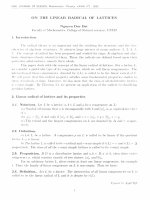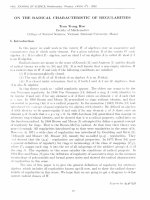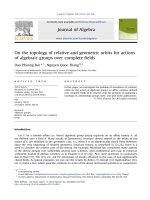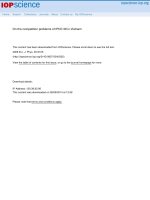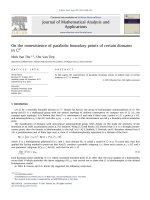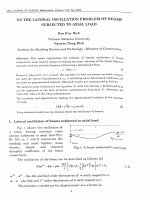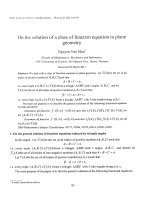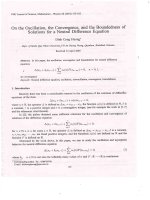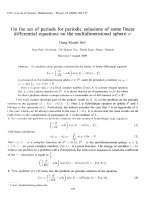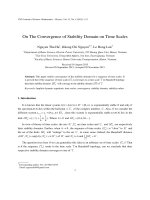DSpace at VNU: On the competition problems of IPhO 39 in Vietnam
Bạn đang xem bản rút gọn của tài liệu. Xem và tải ngay bản đầy đủ của tài liệu tại đây (426.86 KB, 10 trang )
Home
Search
Collections
Journals
About
Contact us
My IOPscience
On the competition problems of IPhO 39 in Vietnam
This content has been downloaded from IOPscience. Please scroll down to see the full text.
2009 Eur. J. Phys. 30 S105
( />View the table of contents for this issue, or go to the journal homepage for more
Download details:
IP Address: 130.39.62.90
This content was downloaded on 28/08/2014 at 12:58
Please note that terms and conditions apply.
IOP PUBLISHING
EUROPEAN JOURNAL OF PHYSICS
doi:10.1088/0143-0807/30/6/S02
Eur. J. Phys. 30 (2009) S105–S113
On the competition problems of IPhO
39 in Vietnam
Nguyen The Khoi1 , Pham Quy Tu1 and Dam Trung Don2
1
2
Hanoi National University of Education, Vietnam
Hanoi University of Natural Sciences, Vietnam
Received 5 June 2009, in final form 21 September 2009
Published 19 October 2009
Online at stacks.iop.org/EJP/30/S105
Abstract
We report on the competition problems given at the 39th International Physics
Olympiad held in Hanoi, Vietnam, which consist of three theoretical and
one experimental problems. The abbreviated solutions are presented. The
distribution of marks for the problems is also shown.
(Some figures in this article are in colour only in the electronic version)
1. Introduction
The 39th International Physics Olympiad (IPhO 39) took place in Hanoi, Vietnam from
20–29 July 2008. Leaders and students from 82 countries and territories participated.
According to the Statutes of the IPhOs [1] the theoretical examination consists of three
problems of 5 h duration. The experimental examination consists of one or two problems of
5 h duration. The knowledge required to solve the problems is included in the syllabus [2].
During the preparation of the problems, the academic committee also paid attention to
some other aspects, namely, the relation of physics to phenomena observed in nature, in daily
life, the application of physics, pollution and the protection of the environment, and energy
and the use of renewable sources of energy, facts related to the host country Vietnam.
2. Problems
The theoretical part of the competition consists of three problems. The first one entitled
Water-powered rice pounding mortar will be presented in detail in subsection 2.1. The second
problem deals with the Cherenkov effect and its application in ring imaging counters. The third
problem studies the change of pressure in an atmosphere where the temperature depends on the
altitude, and the change of temperature of an adiabatic air parcel moving in this atmosphere.
The obtained results are used to estimate carbon monoxide pollution in Hanoi city. These
two problems can be found on the website of the IPhO: www.jyu.fi/ipho/. The experimental
problem Differential thermometric method will be presented in subsection 2.2.
0143-0807/09/060105+09$30.00
c 2009 IOP Publishing Ltd Printed in the UK
S105
N T Khoi et al
S106
Figure 1. A water-powered rice-pounding mortar.
a =20cm
Bucket
T
Lever
L = 74 cm
8 cm
N
Pestle
G
=300
h= 12 cm
b =15cm
Mortar
Figure 2. Design and dimensions of the rice-pounding mortar.
2.1. Theoretical problem no. 1: water-powered rice-pounding mortar
A rice-pounding mortar is shown in figure 1. It consists of the following parts, as seen in
figure 2: the mortar, basically a wooden container for rice and the lever, which is a tree trunk
with one larger and one smaller end. The lever can rotate around a horizontal axis. A pestle is
attached perpendicularly to the lever at the smaller end. The length of the pestle is such that
it touches the rice in the mortar when the lever lies horizontally. The larger end of the lever is
carved hollow to form a bucket. The shape of the bucket is crucial for the mortar’s operation.
Consider a water-powered rice-pounding mortar with the parameters shown in figure 2.
The mass of the lever (including the pestle but without water) is M = 30 kg. The centre of
mass of the lever is G. The lever rotates around the axis T (projected onto the point T on the
figure). The moment of inertia of the lever around T is I = 12 kg m2. When there is water
in the bucket, the mass of water is denoted as m, and the centre of mass of the water body is
denoted as N. The tilt angle of the lever with respect to the horizontal axis is α.
Neglect friction at the rotation axis and the force due to water falling onto the bucket. In
this problem, we make an approximation that the water surface is always horizontal.
(1) At the beginning, the bucket is empty, and the lever (TG) lies horizontally. Then water
flows into the bucket until the lever starts rotating. The amount of water in the bucket at
this moment is m = 1.0 kg.
1.1. Determine TG.
On the competition problems of IPhO 39 in Vietnam
S107
1.2. Water starts flowing out of the bucket when the angle between the lever and the
horizontal axis reaches α1 . The bucket is completely empty when this angle is α2 .
Determine α1 and α2 .
1.3. Let μ(α) be the total torque (relative to the axis T) which comes from the weight of
the lever and the water in the bucket. μ(α) is zero when α = β. Determine β and the
mass m1 of water in the bucket at this instant.
(2) Let water flow into the bucket with a flow rate , which is constant and small. The
amount of water flowing into the bucket, when the lever is in motion, is negligible.
2.1. Sketch a graph of the torque μ as a function of the angle α, μ(α), during one
operation cycle.
2.2. From the graph discuss and give the geometric interpretation of the value of the total
work Wtotal produced by μ(α) and the work Wpounding that is transferred from the pestle to
the rice.
2.3. From the graph estimate α0 and Wpounding (assume that the kinetic energy of water
flowing out of the bucket is negligible). One may replace curved lines by zigzag lines, if
it simplifies the calculation.
(3) Let water flow into the bucket with a constant rate , but one cannot neglect the amount
of water flowing into the bucket during the motion of the lever.
3.1. Assume that the bucket is always overflown with water.
3.1.1. To which kind of equilibrium does the position α = β of the lever belong?
3.1.2. Find the analytic form of the torque μ(α) as a function of α when α = β + α,
and α is small.
3.1.3. Write down the equation of motion of the lever, which moves with zero initial
velocity from the position α = β + α ( α is small). Show that the motion is, with good
accuracy, a harmonic oscillation. Compute the period τ .
3.2. At a given , the bucket is overflown with water at all times only if the lever moves
sufficiently slowly. Determine the minimal value 1 of (in kg/s) so that the lever can
make a harmonic oscillation with amplitude 1◦ .
3.3. If is too large the mortar cannot operate. Assuming that the motion of the lever
is that of a harmonic oscillator, estimate the minimal flow rate 2 for the rice-pounding
mortar not to work.
Solutions
(1)
1.1. TG = 0.016 m.
1.2. At the tilt angle α1 , the water level is at the edge of the bucket and the water volume
is 10−3 m3 . From the geometry of the bucket, we find α1 = 20.6◦ and α2 = 30◦ .
1.3. m = 0.61 kg and β = 23.6◦ .
(2)
2.1. The graph of μ(α) is shown in figure 3.
2.2. Wtotal = the area enclosed by the curve (OABCDFO).
Wpounding = the area of (OEDFO) = gM × TG × sin α0 = 4.6 sin α0 .
2.3. Approximating (OABO) by a triangle and (BEDCB) by a trapezoid, we obtain
α0 = 34.7◦ and Wpounding ≈ 2.6 J.
(3)
3.1.
3.1.1. α = β is a stable equilibrium of the lever.
3.1.2. By calculating the mass of water in the bucket when the lever tilts with angle
α, we find that when α increases from β to β + α, the mass of water increases by
N T Khoi et al
S108
µ
2.7 N.m
A
23.6o
O
20.6o B
-4.6 cos
30o
0 N.m
E
0
D
-4.0 N.m
-4.6 N.m F
C
Figure 3. Graph of μ(α).
2
2
ρ
ρ
m = − 2bh
α ≈ − 2bh
α. The torque μ acting on the lever when the tilt
sin2 α
sin2 β
is β + α equals the torque due to m, and μ = m × g × TN × cos(β + α) or
μ = −47.2 × α N m ≈ −47 × α N m.
2
3.1.3. The equation of motion of the lever is μ = I ddtα2 , where μ = − 47 × α,
α = β + α and I = I (α) ≈ I (β); I = 12 + 0.6 × 0.782 = 12.36 ≈ 12.4 kg m2 . We
2
have −47 × α = 12.4 × ddt 2α . That is the equation for a harmonic oscillator with period
τ = 2π
12.4
47
= 3.227 ≈ 3.2 s.
3.2. Assume that the lever oscillates harmonically with amplitude α0 around α = β.
The equation of motion is α = − α0 sin(2π t/τ ), therefore d( α) = dα =
− α0 (2π/τ ) cos(2π t/τ ) dt.
For the bucket to be overflown, during the time dt the amount of water falling to the bucket
2
ρ
α0 πbh2 ρ dt
should be at least dm = − 2bh
; dm is maximum at t = 0
dα = 2 2τ
cos 2πt
τ
sin2 β
sin2 β
2
2
ρ α0
ρ α0
and equals dm0 = πbh
dt. Because dm0 = dt, then = πbh
. The condition
τ sin2 β
τ sin2 β
for the lever to have a harmonic oscillation with amplitude α0 = 1◦ is
1 with
πbh2 ρ2π
−1
−1
≈ 0.23 kg s .
1 = 360τ sin2 β = 0.2309 kg s
3.3. If the bucket remains overflown when the tilt decreases to 20.6◦ , then the amount of
water in the bucket should reach 1 kg at this time, and the lever oscillates harmonically
with amplitude equal to β − α1 = 23.6◦ − 20.6◦ = 3◦ . The flow should exceed 3 1 ,
therefore 2 = 3 × 0.23 ≈ 0.7 kgs−1 . This is the minimal flow rate for the rice-pounding
mortar not to work.
Discussion. Neglecting the angular momentum variation of the lever due to the collision of
water falling onto the bucket simplifies the solution. If one takes it into account, the shape
of the curve μ(α) is nearly unchanged; only the maximal angle α0 increases and therefore
Wpounding may also increase.
On the competition problems of IPhO 39 in Vietnam
R1
E
S109
R2
V
V1
D1
D2
V2
Figure 4. Schematic circuit diagram of the experimental setup.
2.2. Experimental problem; differential thermometric method
In this experiment, forward-biased silicon diodes
are used as sensors to measure temperature. The voltage drop across a diode at constant bias
current depends linearly on the diode’s temperature T as V (T ) = V (T0 ) − α(T − T0 ), where
0 ◦ C < T < 100 ◦ C, T0 is the room temperature and α = (2.00 ± 0.03) mV ◦ C−1 .
If two diodes D1 and D2 are connected in an electric circuit as shown in figure 4 and placed
at different temperatures T1 and T2 respectively, then the voltage V , called the differential
voltage, is V = V2 (T2 ) − V1 (T1 ) = V (T0 ) − α(T2 − T1 ). By measuring V , we can
determine T = T2 − T1 . This method is called the differential thermometric method.
2.2.1. Differential thermometric method.
We use
the differential thermometric method to determine the temperature of solidification Ts of a
crystalline substance.
Two small identical metallic dishes, each with a diode temperature sensor fixed to it, are
put on a steel plate. The sample dish contains a small amount (about 10 mg) of the substance
to be studied. The reference dish is empty. The steel plate with the two dishes is first heated
by a halogen lamp to a temperature higher than Ts . Then the lamp is switched off, and the
plate is left to cool down. While there is no phase change in the substance, the temperatures
Tsamp of the sample dish and Tref of the reference dish vary at nearly the same rate, and thus
T = Tref − Tsamp varies slowly with Tsamp . During the phase change (the solidification),
Tsamp does not vary and equals Ts , while Tref steadily varies, so that T varies quickly. The
plot of T versus Tsamp shows an abrupt change. The value of Tsamp corresponding to the
abrupt change of T is indeed Ts .
The student is asked to monitor the change in Vsamp and V with time t and to note the
values of Vsamp and V every 10 s–20 s in a table. He or she plots Vsamp versus t and V
versus Vsamp . Examples of these two graphs are given in figures 5 and 6. From figure 5,
the student deduces Ts by the traditional method. From figure 6, he/she deduces Ts by the
differential thermometric method.
2.2.2. Task 1. Finding the temperature of solidification of a crystalline substance.
2.2.3. Task 2. Determining the maximum efficiency of a solar cell under illumination of an
incandescent lamp.
P
(1) The efficiency of a solar cell is determined as η = E×S
, where P is the electric power
cell
the solar cell provides for the load, E is the irradiance and Scell is the area of the solar cell.
To measure the irradiance, a radiation detector is used, which consists of a hollow
cone made of copper, the inner surface of which is blackened with soot. The measuring
diode D2 is fixed to the cone. The reference diode D1 is placed on the inner side of the
wall of the box containing the detector; its temperature equals that of the surroundings
N T Khoi et al
S110
Vsamp[mV]
520
510
500
490
0
150
t [s]
300
450
Figure 5. Voltage of the sample as a function of time.
V [mV]
-4
-5
-6
-7
490
500
510
520
Vsamp[mV]
Figure 6. Voltage difference in relation to the voltage on the sample.
T0 . When the detector receives energy from radiation, it heats up. At the same time, the
detector loses its heat by several mechanisms, such as thermal conduction, convection,
radiation etc.
The detector is placed under a lamp, which serves as a light source. The variation
of the difference between the temperature of the detector and that of the surroundings
T = T − T0 with time t from the moment the detector begins to receive the light with
constant irradiation is given by
1 − e− C t ,
(1)
k
where C is the heat capacity of the detector, whose value is given, is the radiant power
which is related to the area S of the illuminated surface by E = /S. Assume that at t =
0, T = 0, and the heat-missing rate is k T , where k is a constant.
When the radiation is switched off, the temperature difference T varies with time
according to the formula
T (t) =
T (t) =
where
k
T (0) e− C t ,
k
T (0) is the temperature difference at t = 0.
(2)
On the competition problems of IPhO 39 in Vietnam
S111
4
P [mW]
3
2
1
0
3
5
7
9
11
13
I [mA]
Figure 7. Electric power in the load as a function of the current through the cell.
(2) The student has to place the detector under the lamp and switch the lamp on to illuminate
the detector. Every 10–15 s, he/she writes down a value of V in a table. After 2 min,
he/she switches the lamp off. The lamp is then moved away from the detector. Every
10–15 s, the student writes down a value of V in a table.
With the data obtained when the detector is illuminated, the student is asked to plot
a corresponding graph, with variables x and y chosen appropriately, in order to prove that
equation (1) is satisfied. He/she has also to plot the data when the detector ceases to be
illuminated in order to prove that equation (2) is satisfied. The student has to choose two
sets of variables x and y for the two cases, so that the plots are linear. From the plots, the
student can determine the value of k and and calculate the value of E.
(3) The student now puts the solar cell in the place where the radiation detector was, and
connects the solar cell to an appropriate electric circuit comprising multimetres and a
variable resistor. He/she is asked to change the value of the load of the cell by rotating
the knob of the variable resistor, to note the values of current I and voltage V at each
position of the knob and to plot a graph of the electric power in the load, that is I × V ,
as a function of the current I through the cell. From the graph, the student determines the
maximum power Pmax that the solar cell can provide for the load and estimate its error.
Then he/she calculates the maximum efficiency of the solar cell and its error.
We give an example of the solution in figure 7. The maximal power of the solar cell
calculated from the graph is Pmax = 3.7 ± 0.2 mW.
Pmax
= 0.058 ± 0.008.
The maximal efficiency of the solar cell is ηmax = E×S
cell
3. Results
The results of the competition for all the 376 students are presented in the charts in figure 8. The
mean value and standard deviation of the scores are given in table 1. As stated in the Statutes,
from the grading results the organizers establish minima (expressed in points) according to
the following rules:
(a)
(b)
(c)
(d)
A gold medal should be awarded to 6% of the contestants.
Gold or silver medals should be awarded to 18% of the contestants.
Gold, silver or bronze medals should be awarded to 36% of the contestants.
An Olympic medal or honourable mention should be awarded to 60% of the contestants.
N T Khoi et al
Theory 2
Theory 1
140
130
120
110
100
90
80
70
60
50
40
30
20
10
0
0
1
2
3
4
5
6
7
8
9
100
Number of contestants
Number of contestants
S112
10
90
80
70
60
50
40
30
20
10
0
0
1
2
3
110
100
90
80
70
60
50
40
30
20
10
0
1
2
3
4
5
6
7
8
9
12
14
16
18
10
6
7
8
9
35
30
25
20
15
10
5
0
10
0
2
4
6
8
Points
Number of contestants
5
Experiment
Theory 3
120
0
4
Points
Number of contestants
Number of contestants
Points
10
20
Points
Total score
30
25
20
15
10
5
0
0
2
4
6
8 10 12 14 16 18 20 22 24 26 28 30 32 34 36 38 40 42 44 46 48 50
Points
Figure 8. Distribution of the scores.
Table 1. Mean value and standard deviation of the scores.
Problem
Mean value
Standard deviation
Theoretical problem 1
Theoretical problem 2
Theoretical problem 3
Experimental problem
Total score
2.21
3.40
2.55
11.96
20.12
1.53
2.77
2.72
4.83
9.68
The corresponding minima should be expressed as integers by rounding off to the nearest
lower integers.
The minima for awarding the medals and the honourable mention were established for
IPhO 39, as given in table 2. According to these limits, 46 gold medals, 47 silver medals,
78 bronze medals and 87 honourable mentions were awarded. Special awards were given to
On the competition problems of IPhO 39 in Vietnam
S113
Table 2. Minima for awards.
Gold medal
Silver medal
Bronze medal
Honourable mention
33 points
26 points
21 points
14 points
•
•
•
•
•
Longzhi Tan (China) for the best total score (44.6 points)
Longzhi Tan (China) for the best score in the theoretical part (26.1 points)
Yi-Shu Wei (Taiwan) for the best score in the experimental part (20 points)
Andrada Ianus (Romania) for the best score among female participants
Efrain Alfonso P´erez Argandona (Chile) for the best participant among the countries that
first joined the IPhO in 2008 (Gorzkowski Prize)
• Huynh Minh Toan (Vietnam) for the best participant from the host country.
In conclusion, we have presented the competition problems and the main results of IPhO
39, Vietnam.
References
[1] Statutes of the International Physics Olympiads />[2] The Syllabus (Appendix to the Statutes of the International Physics Olympiads) />
